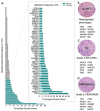Morphologic and Genomic Heterogeneity in the Evolution and Progression of Breast Cancer
- PMID: 32244556
- PMCID: PMC7226487
- DOI: 10.3390/cancers12040848
Morphologic and Genomic Heterogeneity in the Evolution and Progression of Breast Cancer
Abstract
: Breast cancer is a remarkably complex and diverse disease. Subtyping based on morphology, genomics, biomarkers and/or clinical parameters seeks to stratify optimal approaches for management, but it is clear that every breast cancer is fundamentally unique. Intra-tumour heterogeneity adds further complexity and impacts a patient's response to neoadjuvant or adjuvant therapy. Here, we review some established and more recent evidence related to the complex nature of breast cancer evolution. We describe morphologic and genomic diversity as it arises spontaneously during the early stages of tumour evolution, and also in the context of treatment where the changing subclonal architecture of a tumour is driven by the inherent adaptability of tumour cells to evolve and resist the selective pressures of therapy.
Keywords: Breast cancer; genomics; intra-tumour heterogeneity; metastasis; subclonal diversity; treatment resistance.
Conflict of interest statement
The authors declare no conflict of interest
Figures



Similar articles
-
Intratumor Heterogeneity: Novel Approaches for Resolving Genomic Architecture and Clonal Evolution.Mol Cancer Res. 2017 Sep;15(9):1127-1137. doi: 10.1158/1541-7786.MCR-17-0070. Epub 2017 Jun 8. Mol Cancer Res. 2017. PMID: 28596419 Review.
-
Subclonal heterogeneity and evolution in breast cancer.NPJ Breast Cancer. 2021 Dec 21;7(1):155. doi: 10.1038/s41523-021-00363-0. NPJ Breast Cancer. 2021. PMID: 34934048 Free PMC article. Review.
-
Intratumoral heterogeneity and subclonal diversification of early breast cancer.Breast. 2017 Aug;34 Suppl 1:S36-S42. doi: 10.1016/j.breast.2017.06.025. Epub 2017 Jun 27. Breast. 2017. PMID: 28666921 Review.
-
Overview of resistance to systemic therapy in patients with breast cancer.Adv Exp Med Biol. 2007;608:1-22. doi: 10.1007/978-0-387-74039-3_1. Adv Exp Med Biol. 2007. PMID: 17993229 Review.
-
Clonal evolution and heterogeneity in metastatic head and neck cancer-An analysis of the Austrian Study Group of Medical Tumour Therapy study group.Eur J Cancer. 2018 Apr;93:69-78. doi: 10.1016/j.ejca.2018.01.064. Epub 2018 Mar 20. Eur J Cancer. 2018. PMID: 29477794
Cited by
-
Development of an interpretable machine learning model for Ki-67 prediction in breast cancer using intratumoral and peritumoral ultrasound radiomics features.Front Oncol. 2023 Nov 17;13:1290313. doi: 10.3389/fonc.2023.1290313. eCollection 2023. Front Oncol. 2023. PMID: 38044998 Free PMC article.
-
Discordance in biomarker expression between primary breast cancers and loco-regional recurrences: a comprehensive analysis of 112 cases.Gland Surg. 2024 Nov 30;13(11):2107-2115. doi: 10.21037/gs-24-364. Epub 2024 Nov 26. Gland Surg. 2024. PMID: 39678418 Free PMC article.
-
Circulating Tumor Cells as a Tool to Untangle the Breast Cancer Heterogeneity Issue.Biomedicines. 2021 Sep 16;9(9):1242. doi: 10.3390/biomedicines9091242. Biomedicines. 2021. PMID: 34572427 Free PMC article. Review.
-
The FGF/FGFR System in Breast Cancer: Oncogenic Features and Therapeutic Perspectives.Cancers (Basel). 2020 Oct 18;12(10):3029. doi: 10.3390/cancers12103029. Cancers (Basel). 2020. PMID: 33081025 Free PMC article. Review.
-
Estrogen receptor-α signaling in post-natal mammary development and breast cancers.Cell Mol Life Sci. 2021 Aug;78(15):5681-5705. doi: 10.1007/s00018-021-03860-4. Epub 2021 Jun 22. Cell Mol Life Sci. 2021. PMID: 34156490 Free PMC article. Review.
References
-
- WHO Classification of Tumours Editorial Board . World Health Organisation Classification of Tumours: Breast Tumours. 5th ed. International Agency for Research on Cancer (IARC); Lyon, France: 2019.
-
- Sorlie T., Perou C.M., Tibshirani R., Aas T., Geisler S., Johnsen H., Hastie T., Eisen M.B., van de Rijn M., Jeffrey S.S., et al. Gene expression patterns of breast carcinomas distinguish tumor subclasses with clinical implications. Proc. Natl. Acad. Sci. USA. 2001;98:10869–10874. doi: 10.1073/pnas.191367098. - DOI - PMC - PubMed
Publication types
Grants and funding
LinkOut - more resources
Full Text Sources

